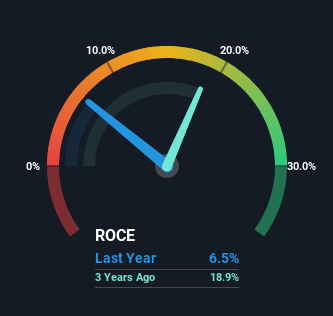Here's What's Concerning About Jiujiuwang Food International's (HKG:1927) Returns On Capital

What trends should we look for it we want to identify stocks that can multiply in value over the long term? Typically, we'll want to notice a trend of growing return on capital employed (ROCE) and alongside that, an expanding base of capital employed. This shows us that it's a compounding machine, able to continually reinvest its earnings back into the business and generate higher returns. Although, when we looked at Jiujiuwang Food International (HKG:1927), it didn't seem to tick all of these boxes.
Return On Capital Employed (ROCE): What Is It?
For those that aren't sure what ROCE is, it measures the amount of pre-tax profits a company can generate from the capital employed in its business. To calculate this metric for Jiujiuwang Food International, this is the formula:
Return on Capital Employed = Earnings Before Interest and Tax (EBIT) ÷ (Total Assets - Current Liabilities)
0.065 = CN¥33m ÷ (CN¥725m - CN¥220m) (Based on the trailing twelve months to June 2024).
Thus, Jiujiuwang Food International has an ROCE of 6.5%. Even though it's in line with the industry average of 7.4%, it's still a low return by itself.
View our latest analysis for Jiujiuwang Food International

Historical performance is a great place to start when researching a stock so above you can see the gauge for Jiujiuwang Food International's ROCE against it's prior returns. If you're interested in investigating Jiujiuwang Food International's past further, check out this free graph covering Jiujiuwang Food International's past earnings, revenue and cash flow.
How Are Returns Trending?
When we looked at the ROCE trend at Jiujiuwang Food International, we didn't gain much confidence. Over the last five years, returns on capital have decreased to 6.5% from 36% five years ago. Given the business is employing more capital while revenue has slipped, this is a bit concerning. This could mean that the business is losing its competitive advantage or market share, because while more money is being put into ventures, it's actually producing a lower return - "less bang for their buck" per se.
On a related note, Jiujiuwang Food International has decreased its current liabilities to 30% of total assets. So we could link some of this to the decrease in ROCE. What's more, this can reduce some aspects of risk to the business because now the company's suppliers or short-term creditors are funding less of its operations. Some would claim this reduces the business' efficiency at generating ROCE since it is now funding more of the operations with its own money.
The Key Takeaway
We're a bit apprehensive about Jiujiuwang Food International because despite more capital being deployed in the business, returns on that capital and sales have both fallen. It should come as no surprise then that the stock has fallen 49% over the last three years, so it looks like investors are recognizing these changes. Unless there is a shift to a more positive trajectory in these metrics, we would look elsewhere.
One more thing: We've identified 5 warning signs with Jiujiuwang Food International (at least 2 which make us uncomfortable) , and understanding these would certainly be useful.
If you want to search for solid companies with great earnings, check out this free list of companies with good balance sheets and impressive returns on equity.
New: Manage All Your Stock Portfolios in One Place
We've created the ultimate portfolio companion for stock investors, and it's free.
• Connect an unlimited number of Portfolios and see your total in one currency
• Be alerted to new Warning Signs or Risks via email or mobile
• Track the Fair Value of your stocks
Have feedback on this article? Concerned about the content? Get in touch with us directly. Alternatively, email editorial-team (at) simplywallst.com.
This article by Simply Wall St is general in nature. We provide commentary based on historical data and analyst forecasts only using an unbiased methodology and our articles are not intended to be financial advice. It does not constitute a recommendation to buy or sell any stock, and does not take account of your objectives, or your financial situation. We aim to bring you long-term focused analysis driven by fundamental data. Note that our analysis may not factor in the latest price-sensitive company announcements or qualitative material. Simply Wall St has no position in any stocks mentioned.
About SEHK:1927
Jiujiuwang Food International
An investment holding company, manufactures and sells confectionary products in the People’s Republic of China, rest of Asia, Europe, and internationally.
Mediocre balance sheet low.
Market Insights
Community Narratives



